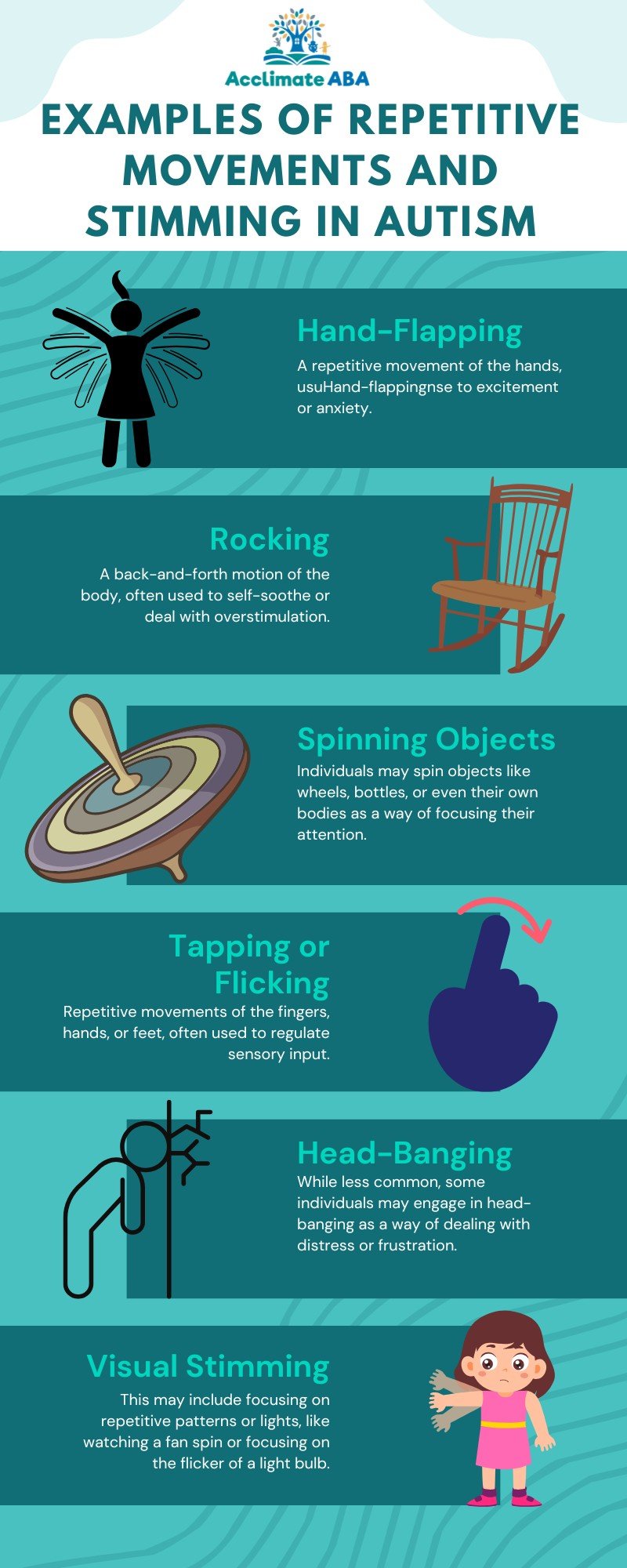Repetitive Movements and Stimming in Autism Explained

Key Points:
- Repetitive movements and stimming are common behaviors in autism, offering a way for individuals to self-regulate or process sensory input.
- These behaviors can include hand-flapping, rocking, or focusing on specific objects.
- Understanding the reasons for stimming and finding strategies for managing it is key to supporting those with autism.
Repetitive movements and stimming are hallmarks of Autism Spectrum Disorder (ASD). According to studies, approximately 80% of autistic adults report that they engage and enjoy various forms of stimming, which includes repetitive behaviors like hand-flapping, rocking, or other movements.
For some, these behaviors are soothing; for others, they are a way of processing overwhelming sensory information, often as a response to sensory overload. Understanding these behaviors and why they happen is crucial for parents and caregivers to offer the right support.
In this article, we will explore what repetitive movements and stimming are, why individuals with autism engage in them, and how these behaviors can be managed or redirected to support better daily functioning.
What are Repetitive Movements in Autism?
Repetitive movements in autism, often referred to as “stimming,” are a range of physical behaviors that individuals on the spectrum may engage in, usually repeatedly and in a consistent pattern. These behaviors can include actions such as hand-flapping, rocking back and forth, spinning, or tapping, among others.
While these movements might seem unusual or out of place to others, they play a critical role in helping individuals with autism cope with sensory overload, manage stress, or regulate their emotions. For many, stimming serves as a way to create comfort and a sense of control in a world that may feel overwhelming or unpredictable.
Though stimming is generally harmless, it can sometimes interfere with social interactions, learning experiences, or daily tasks, particularly if the behavior is disruptive or draws unwanted attention. It’s important to recognize that stimming behaviors aren’t intentional or meant to be disruptive—they are coping mechanisms that help individuals manage their environment.
Why Do Individuals with Autism Engage in Repetitive Movements?
The question of why repetitive movements occur in autism is complex and multifaceted. While these behaviors may seem strange, they often serve an important purpose for the individual. Below, we will explore some of the key reasons behind these repetitive behaviors:
1. Sensory Regulation
One of the primary reasons individuals with autism engage in repetitive movements is to regulate sensory input. Many people on the autism spectrum experience sensory processing differences, where their brain either overreacts or underreacts to certain sensory stimuli.
For example, loud noises, bright lights, or even certain textures may be overwhelming for someone with autism. Stimming can help individuals self-regulate and deal with these sensory challenges.
- Rocking or swaying may help to calm down and reduce sensory overload.
- Hand-flapping or finger-flicking might be used to focus attention and process visual or tactile sensory input.
In this context, stimming is a way to regain control over sensory experiences and create a more predictable environment for the person with autism.
2. Emotional Regulation
Repetitive movements also serve as a form of emotional regulation. Emotions like anxiety, stress, and excitement can be challenging for individuals with autism to manage. Engaging in repetitive movements, such as rocking or tapping, provides a predictable and soothing activity that can help to reduce emotional intensity and bring the person back to a state of calm.
- Hand-flapping might occur during moments of joy or excitement, while body swaying could happen during feelings of anxiety or nervousness.
- These behaviors can provide comfort and reassurance when other means of emotional regulation are unavailable or less effective.
3. Self-Stimulation and Focus
Stimming can also function as a form of self-stimulation, allowing the individual to focus their attention on something that feels safe and predictable. For individuals with autism who may have difficulty with attention and focus, repetitive movements can help filter out distracting stimuli and increase concentration.
- Some individuals may engage in visual stimming, such as watching moving objects or spinning wheels, which provides sensory input that helps them focus.
- Other repetitive movements like tapping or swaying may give the person a way to focus when in an environment that feels chaotic or overstimulating.
These repetitive movements are comforting and offer a structured way to block out overwhelming sensory information.
4. Communication and Expression
In some cases, stimming can be a form of nonverbal communication. For individuals with autism who are nonverbal or have limited speech, repetitive behaviors can serve as an expression of internal states, such as excitement, distress, or sensory overload. Understanding the stimming patterns of an individual may offer valuable insights into their emotions or needs.
- For example, a child who starts to flap their hands rapidly might be signaling excitement or joy.
- Rocking might indicate anxiety or the need for comfort.
In these cases, stimming can be seen as a way of expressing what the individual may not have the words to communicate.

These stimming behaviors are not inherently harmful and are part of the way individuals with autism process and interact with the world. However, in some cases, when stimming becomes excessive or disruptive, it may be necessary to intervene.
How to Manage Repetitive Movements and Stimming in Autism
While repetitive movements and stimming are natural, they can sometimes interfere with daily life, especially if they become excessive or disruptive. Fortunately, there are several strategies that can help manage these behaviors in a constructive way:
1. Create a Calming Environment
If sensory overload is contributing to stimming, it’s important to create an environment that is more comfortable. This might include:
- Reducing bright lights or loud noises
- Using noise-canceling headphones or weighted blankets to provide calming sensory input
- Creating a quiet space where the individual can retreat to when feeling overwhelmed
2. Provide Sensory Breaks
Regular sensory breaks can help individuals with autism regulate their sensory needs and reduce the likelihood of excessive stimming. Sensory breaks may include activities such as:
- Deep pressure activities (e.g., squeezing a stress ball or using a weighted vest)
- Movement activities (e.g., jumping on a trampoline or swinging)
- Quiet activities that focus on soothing sensory input, like listening to soft music or doing a calm craft activity
3. Use ABA Therapy to Teach Alternative Behaviors
ABA (Applied Behavior Analysis) therapy is an effective approach for managing stimming behaviors. ABA focuses on reinforcing positive behaviors and reducing those that interfere with daily functioning. Through ABA therapy, individuals with autism can be taught to engage in alternative behaviors that provide the same sensory input without being disruptive. For example:
- Teaching a child to use a fidget toy as a form of stimming rather than hand-flapping
- Reinforcing appropriate ways to express emotions or excitement instead of engaging in repetitive movements
Understanding and managing repetitive movements and stimming in autism is crucial for improving the daily lives of individuals with ASD. With the right strategies and support, stimming behaviors can be reduced or redirected in a way that benefits the individual and those around them. By using therapies like ABA, families can help their loved ones lead more fulfilling, less disruptive lives.
ABA Therapy for Repetitive Movements in Autism in Utah
If you are seeking support for managing repetitive movements and stimming behaviors, Acclimate ABA offers ABA therapy in Utah to help individuals with autism thrive. Our expert therapists work closely with families to develop individualized treatment plans that address stimming behaviors and other challenges related to autism. Through evidence-based interventions, we focus on improving communication, social skills, and emotional regulation.
Whether it’s reducing disruptive behaviors or teaching alternative self-regulation strategies, ABA therapy in Utah from Acclimate ABA is designed to support both individuals and their families. Contact us today to learn more about how our services can help your child manage repetitive movements and stimming behaviors.
